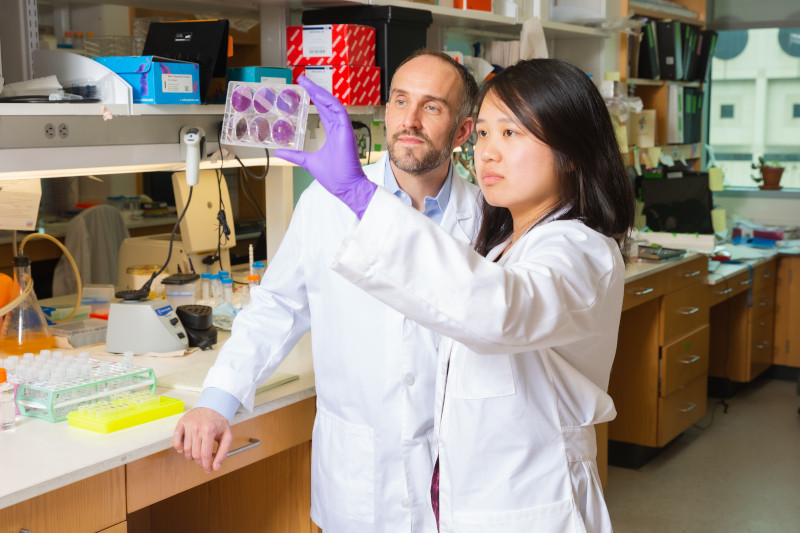DALLAS – March 8, 2020 – A protein produced by the human immune system can potently inhibit several coronaviruses, including the one behind the current COVID-19 outbreak, an international team of investigators reports today. The research reveals that the LY6E protein impairs the coronavirus’ ability to initiate infection, which could lead to treatments for the illness.
Strikingly, mice lacking Ly6e (the mouse version of the gene) were highly susceptible to a usually nonlethal mouse coronavirus, the researchers reported in bioRxiv, an online preprint server that posts articles prior to peer review.
“Remarkably, this potent inhibitory effect carried over to all the coronaviruses we tested, including those responsible for the severe acute respiratory syndrome coronavirus (SARS-CoV) outbreak in 2003, the Middle East respiratory syndrome (MERS) coronavirus in 2012, and the recently emerged causative agent of COVID-19, known as SARS-CoV-2,” says John Schoggins, Ph.D., an associate professor of microbiology at UT Southwestern Medical Center and one of three corresponding authors on the report.
The story begins many years ago when, as a postdoctoral researcher in the lab of Charles Rice, Ph.D., at The Rockefeller University, Schoggins was screening for antiviral genes and found that the LY6E gene unexpectedly enhanced the infectivity of the virus that causes flu. He continued this research on how LY6E enhanced flu infection after becoming a faculty member at UT Southwestern and the project currently is being led by Katrina Mar, Ph.D., a postdoctoral researcher in his laboratory.
In 2017, Stephanie Pfaender, Ph.D., a postdoctoral researcher from the Swiss lab of Volker Thiel, Ph.D., one of the world’s leading experts on coronavirus biology, visited the Rice lab to use Schoggins’ screening technology to find genes that inhibit coronavirus. This led to the discovery that LY6E potently inhibited coronavirus.
“When we later learned that LY6E did the opposite with coronavirus – that is, it inhibited rather than enhanced infection – we were immediately intrigued, particularly because we had already developed an animal model to study the role of LY6E during viral infection,” Schoggins says. Thus, the Thiel and Rice labs began to further study the LY6E protein.
The team had worked for almost two years on its study before the current coronavirus outbreak. They had found that the LY6E protein inhibited other coronaviruses – the ones implicated in SARS and MERS – when the pathogen that causes COVID-19 came to the world’s attention in January, Schoggins says.
In primate kidney cells, which are frequently used as models in coronavirus research, the researchers had determined that LY6E impairs the ability of the virus to fuse with host cells. If the virus is unable to fuse with those cells, it cannot initiate infection, he explains. Thiel was able to get a sample of human COVID-19 from the current outbreak and spearheaded efforts to determine if LY6E also inhibited fusion of the COVID-19 virus, finding that it does.
Meanwhile, Mar conducted experiments on the UT Southwestern mouse model exposed to murine coronavirus that showed Ly6e is critical for protecting immune cells from infection. In the absence of Ly6e, immune cells – such as dendritic cells and B cells – become more susceptible to infection and their numbers drastically decrease. This makes it harder for the immune system to fight off the infection, which worsens the disease, Schoggins says.
He stresses, however, that the mouse coronavirus used in that experiment is very different from the coronavirus in the current outbreak. One major difference: Rather than being a respiratory illness, the mouse coronavirus they studied infects the liver, causing hepatitis. Another difference: The mouse coronavirus is usually not lethal, but for mice lacking Ly6e, it was deadly.
“In spite of those differences, it’s widely accepted as a model for understanding basic concepts of coronavirus replication and immune responses in a living animal,” Schoggins says. “Our study brings new insight into how critical these antiviral genes are for controlling viral infection and mounting proper immune responses against the virus. Because LY6E is a naturally occurring protein in humans, we hope this knowledge may help in the development of therapies that might one day be used to treat coronavirus infections.”
The researchers conclude in their study that antiviral fusion inhibitors have been successfully implemented for HIV-1 and that a therapeutic approach mimicking the mechanism of action of LY6E could provide a first line of defense against novel coronavirus infections.
UTSW co-authors include Wenchun Fan, Mary Wright-Carter, and Natasha Hanners. Others involved in the study include Eleftherios Michailidis, Markus Hoffman, H. Heinrich Hoffman, and Mohsan Saeed of Rockefeller University; Annika Kratzel, Dagny Hirt, Philip V’kovski, Nadine Ebert, Hanspeter Stalder, Ronald Dijkman, and Gert Zimmer of the Institute of Virology and Immunology and the University of Bern in Switzerland; Eike Steinmann and Daniel Todt of the Ruhr-Universität, Bochum, Germany, where co-lead author Pfaender also has a position; Hannah Kleine-Weber and Stefan Pöhlmann of Deutsches Primatenzentrum GmbH, LeibnizInstitut für Primatenforschung, Göttingen, Germany; and Thomas Gallagher of the University of Chicago.
The research was supported by the National Institutes of Health (grants AI117922, AI132751, and AI091707), The Clayton Foundation, the American Lung Association, The Burroughs Wellcome Fund, Swiss National Science Foundation (grants 166265, 310030_173085, and CRSII3_160780), the European Commission’s Horizon 2020 Research and Innovation Program, and the Federal Ministry of Education and Research (grants: RAPID Consortium, 01KI1723A, and 01KI1723D).
About UT Southwestern Medical Center
UT Southwestern, one of the premier academic medical centers in the nation, integrates pioneering biomedical research with exceptional clinical care and education. The institution’s faculty has received six Nobel Prizes, and includes 22 members of the National Academy of Sciences, 17 members of the National Academy of Medicine, and 14 Howard Hughes Medical Institute Investigators. The full-time faculty of more than 2,500 is responsible for groundbreaking medical advances and is committed to translating science-driven research quickly to new clinical treatments. UT Southwestern physicians provide care in about 80 specialties to more than 105,000 hospitalized patients, nearly 370,000 emergency room cases, and oversee approximately 3 million outpatient visits a year.
Original post https://alertarticles.info
